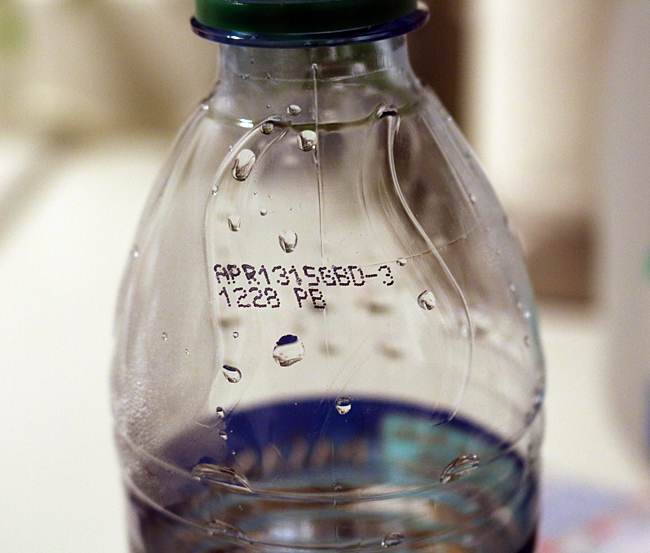“U nless the source of the water used for hot drinks is either bottled or not from airplane itself — or, at least, is hot enough to have been boiled — it may not be completely safe to drink. Zach Bjornson-Hooper — also known as FlyerTalk member T-wiz and the son of FlyerTalk member l’etoile — took samples of water from different commercial aircraft on a trip back in 2002 and used them as part of a science project at the age of 13 years old. His persistence and innovative results found — among other things — insect eggs that days later in the lab hatched into maggots; and The Wall Street Journal published his experiments and findings. I briefly revisited the potability of water aboard commercial aircraft in this short article posted on Friday, June 25, 2010 here at The Gate.”
The paragraph you just read was excerpted from this article of 16 Tips on How to Use and Leave a Lavatory Aboard an Airplane which I wrote on Tuesday, February 2, 2016; and the information still holds true today, as water tanks within an aircraft are considered difficult to clean properly and that you can actually risk becoming ill if you drink the water dispensed aboard airplanes — especially as the water can contain insect eggs, debris and such bacteria as Coliform even after the tanks are supposedly cleaned…
Will Water Dispensed Aboard Airplanes Be Safe to Drink?
…but if the team of people at a water disinfection company based in Kentucky southwest of Cincinnati called AquiSense Technologies has it their way, water dispensed aboard airplanes will be considered completely potable and could render the use of bottled water served aboard many airplanes by flight attendants obsolete — which could potentially be good news for passengers who are thirsty but do not want to pay up to three dollars for water.
The new technique known as PearlAqua and developed by AquiSense purportedly relies on ultraviolet light disinfection technology produced by sturdier light emitting diodes which generate high levels of UV-C photons capable of penetrating cells and damaging the nucleic acid — supposedly thus rendering them incapable of reproduction or microbiologically inactive — while meeting the space and weight constraints of airlines which include handling stresses such as the shocks caused by hard and rough landings.
Carbon or ceramic filters; treatment with chemicals like chlorine; and ultraviolet lighting systems based on mercury-vapor lamps are some of the unsuccessful attempts with various methods to eliminate the problem of water dispensed aboard airplanes which is not considered potable. All of the aforementioned methods have issues which render them ineffective or impractical pertaining to treating water tanks aboard airplanes. Conventional ultraviolet sterilization is considered dangerous because ultraviolet lights typically contain mercury — and because the ultraviolet lights are fragile, they could potentially contaminate drinking water if they are damaged.
“The small size and instant on/off capabilities mean this [LED] technology can be placed near the water dispensing point, such as a sink or galley faucet, and switched-on only when water is flowing,” a representative of AquiSense said, according to this article written by Chris McGinnis of TravelSkills. “Disinfecting the water right before it reaches a user blocks contamination coming from the piping and diminishes the need for residual disinfection chemicals.”
Safe Drinking Water Aboard Airplanes? Not So Fast…
One person who has specific experience with testing water dispensed aboard airplanes is not quite optimistic — yet, anyway.
“It could work, but hasn’t been certified for efficacy yet”, according to Zach Bjornson — an immunologist and microbiologist who earned his doctor of philosophy degree at Stanford University School of Medicine — who is the same person mentioned at the beginning of this article. “Disinfection is typically difficult. The tricky thing with UV is that normal bulbs have varying output and the output is not usually metered, so you can’t tell if they’re working easily. I’m not familiar with UV LEDs. I’m skeptical that enough UV radiation could be emitted for point-of-use; usually contact time with UV radiation is minutes I think. We would need to see more info from the vendor.”
Summary
In a world which is awaiting the second iteration of supersonic travel; airplanes powered by solar energy or electricity; and other fascinating technological advances, passengers should eventually see the day when they can drink water dispensed aboard airplanes without concern or worry — but although that day has not arrived just yet, the team at AquiSense hopes that the technology it developed will be available in the form of test units as soon as next year…
…but with the cost of the water treatment units estimated to be as expensive as $3,000.00 — and I assume that does not include maintenance costs — McGinnis concludes that if airlines are “making money peddling bottled water on the plane, that could be a hard sell.”
Supposedly like the water inside of them, the days of bottled water served aboard airplanes may not expire just yet…
Photograph ©2014 by Brian Cohen.

